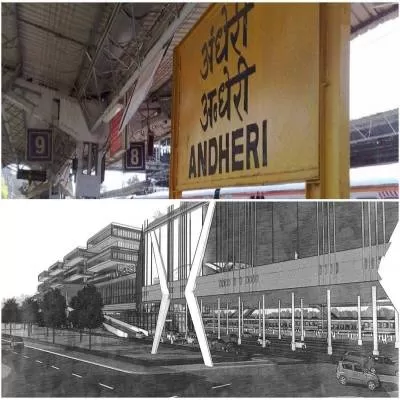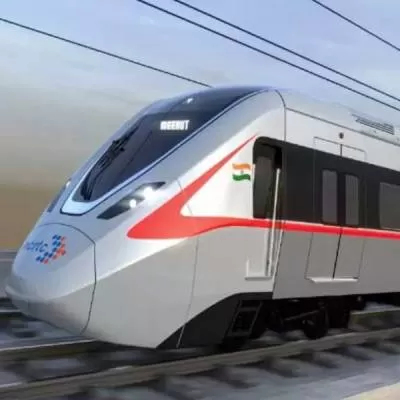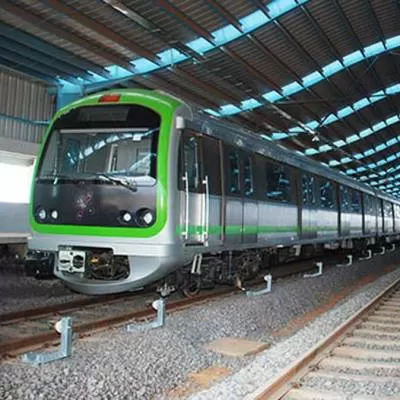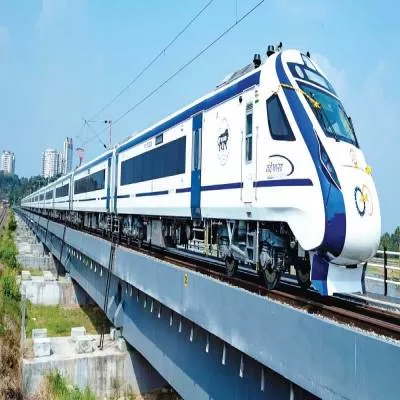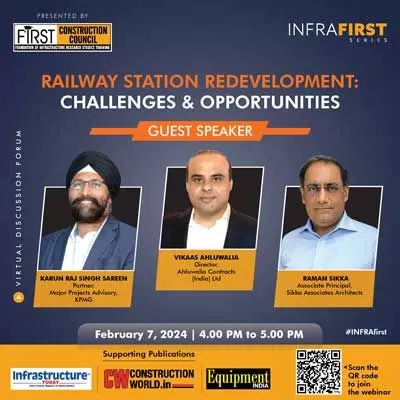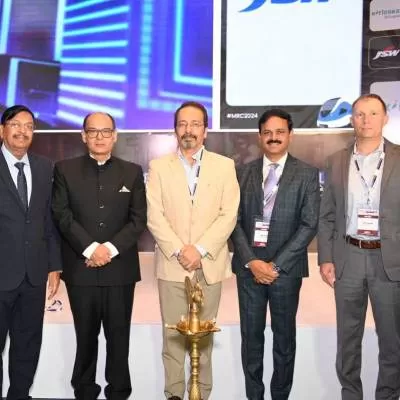- Home
- Infrastructure Transport
- RAILWAYS & METRO RAIL
- Getting Back on Track

Getting Back on Track
In the recently announced Railway Budget, Railway Minister Suresh Prabhu announced that the government would put up stations for development online, allowing private enterprises to come forward with proposals. This statement has raised the hopes of many, from commuters eager to finally experience quality railway infrastructure to companies keen on getting their hands on the station development pie. However, such excitement may well be premature considering the track record of the Railways in making good on its promises.
The plan that wasn´t
Consider the fact that station development has been attempted before. In 2012, Indian Railway Stations Development Corporation Ltd (IRSDCL), a JV between IRCON and the Rail Land Development Authority, was established to develop new railway stations and redevelop existing ones. It was supposed to undertake projects to develop real estate on Railways or government land and commercially utilise it as required in connection with the development of railway stations.
Despite a Rs 100-crore budget and six stations - Anand Vihar, Bijwasan, Chandigarh, Habibganj, Shivaji Nagar, Surat - in its kitty, the company has been unable to commission even a single project. Even the feasibility study of the stations is still incomplete.
Process and policy
Here´s the process. Usually, the Railways identify the station for development, mostly aimed at creating satellite stations and modernising major stations. For satellite stations, facilities are to be developed to handle more traffic; thus, an increased number of tracks and platforms is the minimum requirement. Then, there are the surrounding areas of the station-approach roads, parking facilities, power and water, station building-all requiring augmentation depending on anticipated traffic. The feasibility study has to take into account every aspect of the station and its surrounding area as the station cannot function in isolation.
Talking about the cost involved before undertaking a project, Madhukar Parikh, CEO, VNR Infrastructures Limited, says, ¨A detailed project report (DPR) has to be made after selecting a station to understand the feasibility of the project; it is a time and capital-intensive enterprise. It is not just an investment but expenditure till the project materialises.¨
The biggest hurdles
That apart, the biggest challenges for the project to take off remain the same as the ones affecting countless government-sanctioned projects: Lack of clarity in policy and lack of will to execute the project. Commenting on the announcement of putting station development projects online, Subodh Jain, Former Railway Board Member, says, ¨If there is no policy framework backing the announcement, then the talk of redevelopment remains only for public consumption. With almost no monitoring, the projects cannot possibly take off.¨
Meanwhile, Parikh says, ¨There is also a challenge from the legal standpoint as policies are often amended after a change in the political scenario and it becomes vitally necessary to protect the funds invested in a project as arbitration or other legal recourse is time and capital-intensive.¨
Highlighting another reason for the delay, Sunil Srivastava, Managing Director, BARSYL, says, ¨A minimum of 20 approvals are required and that is just to complete a feasibility study.¨ Elaborating further on the company established exclusively for station development, he says, ¨To undertake the feasibility study, the mandate has been given to IRSDC, but there is no particular department or destination for one-point approval. Even the establishment of IRSDC has not helped in ease of operations.¨ For comprehensive development, different approvals are required for every aspect. Apart from city development authority, approvals for power, traffic, water, fire, environment and even two to three levels of approvals from the Railways itself are required.
Although delay in any project is foreseeable, it becomes even more significant here. As Srivastava explains, ¨Plans are drawn on the basis of the projected requirement for a station. So a delay not only has a huge effect on the cost of the project but also sends the planning haywire. As projects are not completed on time, the projected plan, which does not get updated, becomes a fallacy and the project is unable to operate as planned after completion.¨
Possible solutions
How then can the situation improve? Streamlining all the approvals required by setting up a nodal agency would be an important first step.
¨After the suggestion of putting the development works online, technically the IRSDC should function as the monitoring body for the same,¨ reasons Srivastava. ¨But the whole process may end up staying the same with the only difference being that station selection is handed over to the preference of private players.¨ Clarity is also needed on the policy framework and revenue model. ¨The policy suggests that private players are invited for a discussion after selecting a station to take the project forward,¨ says Jain. ¨But who will be party to the discussion? This aspect has to be addressed. Further, attracting private funding is the only way to make investments viable and that can only be possible if a revenue model is in place.¨
To set up parameters to develop the stations, Parikh suggests, ¨Global companies in JV with Indian companies with experience in handling rail infra projects should be sought for understanding the requirements to develop a railway station and set up guidelines.¨ Jain adds, ¨Targets should be set for every project undertaken. You need a target for the approvals and one for the completion of the project coupled with stringent monitoring. Only then will it be possible to witness some concrete development.¨
Moving ahead
When a station development plan is undertaken, it will allow the Railways, the third largest landholder in the country, to capitalise on the open spaces after its operational requirements are fulfilled, providing the much-needed funds for further development. Outsourcing the development of stations will also grant the Railways upgraded infrastructure.
¨The concept is good,¨ says Srivastava. ¨But unless it is done in a time-bound manner and is realistic, it will not be feasible. Station development is like any commercial development but instead of a building above a car parking facility, it is a building with train parking. The Railways has to look at it as a commercial building project so that both the Railways and private players will benefit. If private players put in money, they expect returns. And these can only be achieved through time-bound implementation.¨
Parikh sees a huge opportunity if the challenges are addressed. ¨Rail infrastructure work is immense, right from civil and engineering work to signalling and so on. Timely implementation of projects will definitely benefit the commuters, private enterprises and the Railways. However, until the Railways hesitates in letting go of control and allowing a private entity that has won the contract to develop and maintain the station, the policy changes will not be forthcoming. The mindset has to be changed.¨
To share your views on the railways station development plan, write in at feedback@ASAPPmedia.com
How will the government make good on its promises in the Railway Budget considering the challenges that have traditionally hampered the development of railway infrastructure? CW examines the problems and offers possible solutions. In the recently announced Railway Budget, Railway Minister Suresh Prabhu announced that the government would put up stations for development online, allowing private enterprises to come forward with proposals. This statement has raised the hopes of many, from commuters eager to finally experience quality railway infrastructure to companies keen on getting their hands on the station development pie. However, such excitement may well be premature considering the track record of the Railways in making good on its promises. The plan that wasn´t Consider the fact that station development has been attempted before. In 2012, Indian Railway Stations Development Corporation Ltd (IRSDCL), a JV between IRCON and the Rail Land Development Authority, was established to develop new railway stations and redevelop existing ones. It was supposed to undertake projects to develop real estate on Railways or government land and commercially utilise it as required in connection with the development of railway stations. Despite a Rs 100-crore budget and six stations - Anand Vihar, Bijwasan, Chandigarh, Habibganj, Shivaji Nagar, Surat - in its kitty, the company has been unable to commission even a single project. Even the feasibility study of the stations is still incomplete. Process and policy Here´s the process. Usually, the Railways identify the station for development, mostly aimed at creating satellite stations and modernising major stations. For satellite stations, facilities are to be developed to handle more traffic; thus, an increased number of tracks and platforms is the minimum requirement. Then, there are the surrounding areas of the station-approach roads, parking facilities, power and water, station building-all requiring augmentation depending on anticipated traffic. The feasibility study has to take into account every aspect of the station and its surrounding area as the station cannot function in isolation. Talking about the cost involved before undertaking a project, Madhukar Parikh, CEO, VNR Infrastructures Limited, says, ¨A detailed project report (DPR) has to be made after selecting a station to understand the feasibility of the project; it is a time and capital-intensive enterprise. It is not just an investment but expenditure till the project materialises.¨ The biggest hurdles That apart, the biggest challenges for the project to take off remain the same as the ones affecting countless government-sanctioned projects: Lack of clarity in policy and lack of will to execute the project. Commenting on the announcement of putting station development projects online, Subodh Jain, Former Railway Board Member, says, ¨If there is no policy framework backing the announcement, then the talk of redevelopment remains only for public consumption. With almost no monitoring, the projects cannot possibly take off.¨ Meanwhile, Parikh says, ¨There is also a challenge from the legal standpoint as policies are often amended after a change in the political scenario and it becomes vitally necessary to protect the funds invested in a project as arbitration or other legal recourse is time and capital-intensive.¨ Highlighting another reason for the delay, Sunil Srivastava, Managing Director, BARSYL, says, ¨A minimum of 20 approvals are required and that is just to complete a feasibility study.¨ Elaborating further on the company established exclusively for station development, he says, ¨To undertake the feasibility study, the mandate has been given to IRSDC, but there is no particular department or destination for one-point approval. Even the establishment of IRSDC has not helped in ease of operations.¨ For comprehensive development, different approvals are required for every aspect. Apart from city development authority, approvals for power, traffic, water, fire, environment and even two to three levels of approvals from the Railways itself are required. Although delay in any project is foreseeable, it becomes even more significant here. As Srivastava explains, ¨Plans are drawn on the basis of the projected requirement for a station. So a delay not only has a huge effect on the cost of the project but also sends the planning haywire. As projects are not completed on time, the projected plan, which does not get updated, becomes a fallacy and the project is unable to operate as planned after completion.¨ Possible solutions How then can the situation improve? Streamlining all the approvals required by setting up a nodal agency would be an important first step. ¨After the suggestion of putting the development works online, technically the IRSDC should function as the monitoring body for the same,¨ reasons Srivastava. ¨But the whole process may end up staying the same with the only difference being that station selection is handed over to the preference of private players.¨ Clarity is also needed on the policy framework and revenue model. ¨The policy suggests that private players are invited for a discussion after selecting a station to take the project forward,¨ says Jain. ¨But who will be party to the discussion? This aspect has to be addressed. Further, attracting private funding is the only way to make investments viable and that can only be possible if a revenue model is in place.¨ To set up parameters to develop the stations, Parikh suggests, ¨Global companies in JV with Indian companies with experience in handling rail infra projects should be sought for understanding the requirements to develop a railway station and set up guidelines.¨ Jain adds, ¨Targets should be set for every project undertaken. You need a target for the approvals and one for the completion of the project coupled with stringent monitoring. Only then will it be possible to witness some concrete development.¨ Moving ahead When a station development plan is undertaken, it will allow the Railways, the third largest landholder in the country, to capitalise on the open spaces after its operational requirements are fulfilled, providing the much-needed funds for further development. Outsourcing the development of stations will also grant the Railways upgraded infrastructure. ¨The concept is good,¨ says Srivastava. ¨But unless it is done in a time-bound manner and is realistic, it will not be feasible. Station development is like any commercial development but instead of a building above a car parking facility, it is a building with train parking. The Railways has to look at it as a commercial building project so that both the Railways and private players will benefit. If private players put in money, they expect returns. And these can only be achieved through time-bound implementation.¨ Parikh sees a huge opportunity if the challenges are addressed. ¨Rail infrastructure work is immense, right from civil and engineering work to signalling and so on. Timely implementation of projects will definitely benefit the commuters, private enterprises and the Railways. However, until the Railways hesitates in letting go of control and allowing a private entity that has won the contract to develop and maintain the station, the policy changes will not be forthcoming. The mindset has to be changed.¨ To share your views on the railways station development plan, write in at feedback@ASAPPmedia.com


